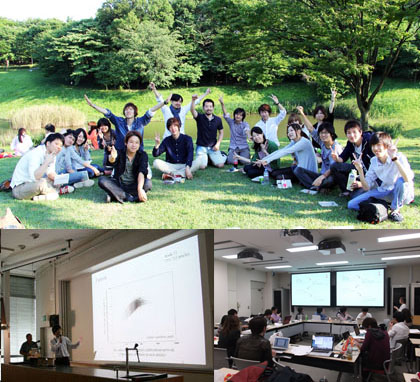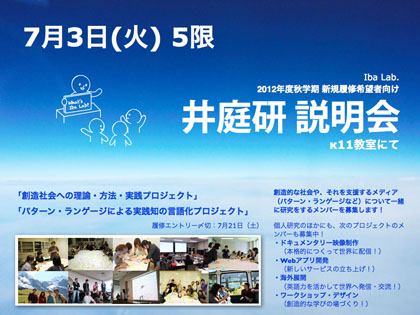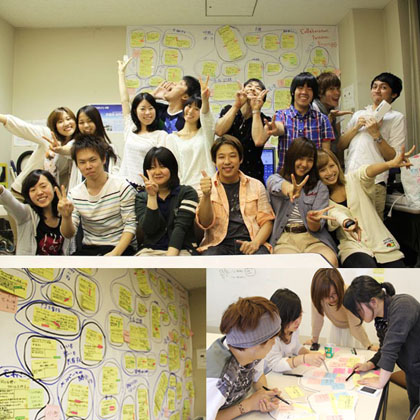Syllabus for Iba Lab B2 (Fall 2012) Exploring Theories, Methods, and Practices for the Creative Society
Syllabus for Iba Lab B2 (Fall 2012)
Exploring Theories, Methods, and Practices for the Creative Society
(This syllabus is updated on 6/26)
We welcome GIGA students who don't speak Japanese!
Important Dates
July 3, 2012: Iba Lab information session (5th hour @ K11)
July 21, 2012: Entry submission deadline
July 26-27, 2012: Interview sessions (dates subject to change)
July 28, 2012: Lab spring presentations
Course Goals and Overview
Our society today is becoming more complex and diverse day by day. Finding a way to design the future with our own hands has become the fundamental problem for us today. To be creative in such a society, we must create our own visions, and design tools and methods to make the vision become a reality.
In our lab, we define a Creative Society as a society where various people design and create new perceptions, new products, new methods, and ultimately the future for ourselves, by ourselves. The lab aims to seize the sprouts of the creative society, imagine its growth, and nurture it through actual practice.
Members of the lab would either work on Personal Projects based on their interest in a certain field, or they can work in one of the Frontier Projects formed by members of the lab.
Examples of personal projects include analysis of open collaborations, research on social media, putting creative workshops to practice, analysis of the creative process, creation of tools to support creative processes, building new forms of communication media, or the creation of a pattern language in a new field. Of course, any other topic that you are interested in is welcome.
We are planning on starting the following Frontier Projects.
Upon conducting your project, you must first let go of the knowledge and methods fixed to existing sciences, and commit to the project by reconstructing a new method for a new era of study. To help the process, we will take time to read and discuss books about related topics.
The theme for our lab is Creativity. We are looking for prospective lab members who are willing to commit creatively to the future!
To find out more about our works, visit our lab blog:
The Creative Systems Lab
http://creativesystemslab.blogspot.jp/

Course Schedule
Progress on each member's project will be shared at lab meetings. In addition, we will read and discuss books, and exercises to polish up skills will be given.
Members are required to work on their projects outside of class time.
Sessions are planned on 5th hour Tuesdays.
Course Language
English, Japanese
We welcome GIGA students who don't speak Japanese!
Course Requirements
Members are required to take classes held by Professor Iba besides the lab sessions, since skills and knowledge necessary for the lab will be taught there also. Professor Iba will be teaching "Pattern Language" and "Complex Systems Theory" in the Fall semester of 2012.
We are looking for members who are willing to study together with us in a long perspective. Breakthrough in knowledge and skills can be expected through long-term commitment.
Available Seats
Approximately 20
Misc. Information
Since members of the lab each have a different field of expertise, knowledge necessary for each member's project must be acquired outside of class.
Classes will most likely be extended without notice. We also go for dinner after lab sessions, so please keep your schedule open for the night on days with lab sessions.
You are welcome to take both Iba Lab B1 and B2 in the same semester, or belong to another lab besides the Iba lab at the same time.
Prospective members are asked to attend the Iba Lab Spring Presentation on 7/28/2012 (Sat).
Join us on opportunities to go on overseas trips to attend workshops and academic conferences. This year we will be visiting Germany in July and the US in October.
Iba Lab members are required to write their graduation thesis in English.
Entry Assignment
After reading through this syllabus thoroughly, please submit the entry assignment described below via email by Saturday, July 21.
Email to: ilab-entry2012 [at] sfc.keio.ac.jp
Subject: Iba Lab B2 Entry
Please attach your entry assignment in a Word or PDF file.
The selection interview will be held based on the information given in the entry assignment.
References
Takashi Iba, "An Autopoietic Systems Theory for Creativity", Procedia - Social and Behavioral Sciences, Vol.2, Issue 4, 2010, pp.6610-6625
Daniel H. Pink, A Whole New Mind: Why Right-Brainers Will Rule the Future, Riverhead Trade, 2006
Don Tapscott, Anthony D. Williams, Wikinomics: How Mass Collaboration Changes Everything, Portfolio Trade, Expanded ed., 2010
Peter Gloor, Coolfarming: Turn Your Great Idea into the Next Big Thing, AMACOM, 2010
Keith Sawyer, Group Genius: The Creative Power of CollaborationBasic Books, 2008
Thomas Kelley, Jonathan Littman, The Art of Innovation: Success Through Innovation the IDEO Way, Profile Business, 2002
Morris Berman, The Reenchantment of the World, Cornell University Press, 1984
Gregory Bateson, Steps to an Ecology of Mind, The University of Chicago Press, 2000
N. Luhmann, Social Systems, Stanford University Press, 1996
Thomas S. Kuhn, The Structure of Scientific Revolution, The University of Chicago Press, 1962
Freeman Dyson, Imagined Worlds, Harvard University Press, 1997
Peter M. Senge, et. al., Presence: Human Purpose and the Field of the Future, Crown Business, Reprint ed., 2008
C. Otto Scharmer, Theory U: Leading from the Future as It Emerges : The Social Technology of Presencing, Berrett-Koehler Pub, 2009
Stephen Grabow, Christopher Alexander: The Search for a New Paradigm in Architecture, Routledge Kegan & Paul, 1983
M. Lynn Manns, L. Rising, Fearless Change: Patterns for Introducing New Ideas, Addison-Wesley, 2004
Learning Patterns Project, Learning Patterns: A Pattern Language for Creative Learning, 2011
Christopher Alexander, The Nature of Order, Book 1-4, Center for Environmental Structure, 2001-
Jenny Quillien, Delight's Muse on Christopher Alexander's The Nature of Order: A Summary and Personal Interpretation, Lulu.Com, 2008
George Lakoff, Mark Johnson, Metaphors We Live By, The University of Chicago Press, 1980
"Deduction, Induction, and Hypothesis" (Charles Sanders Peirce, The Essential Peirce: Selected Philosophical Writings VOLUME 1 (1867-1893), Indiana University Press, 1992) p.186-199
Hayao Miyazaki, Starting Point 1979-1996, VIZ media, 2009
Haruki Murakami, What I Talk about When I Talk about Running: A Memoir, Vintage Books, 2009
B. Minto, The Pyramid Principle: Logic in Writing and Thinking, 3rd Revised ed, Financial Times Prentice Hall, 2008
Exploring Theories, Methods, and Practices for the Creative Society
(This syllabus is updated on 6/26)
We welcome GIGA students who don't speak Japanese!
Important Dates
Course Goals and Overview
Our society today is becoming more complex and diverse day by day. Finding a way to design the future with our own hands has become the fundamental problem for us today. To be creative in such a society, we must create our own visions, and design tools and methods to make the vision become a reality.
In our lab, we define a Creative Society as a society where various people design and create new perceptions, new products, new methods, and ultimately the future for ourselves, by ourselves. The lab aims to seize the sprouts of the creative society, imagine its growth, and nurture it through actual practice.
Members of the lab would either work on Personal Projects based on their interest in a certain field, or they can work in one of the Frontier Projects formed by members of the lab.
Examples of personal projects include analysis of open collaborations, research on social media, putting creative workshops to practice, analysis of the creative process, creation of tools to support creative processes, building new forms of communication media, or the creation of a pattern language in a new field. Of course, any other topic that you are interested in is welcome.
We are planning on starting the following Frontier Projects.
- Documentary Filming - Filming, production, and streaming of the world's first documentary film about pattern languages. Those with skills in film editing are welcome.
- Web Application Development - Launch a new kind of social networking service based on pattern languages. We welcome those with high programming and software development skills.
- Global Expansions - Introduce pattern languages and workshops based on them overseas. For all of you out there with high English skills, this is the place for you.
- Workshop Design - Develop and carry out new forms of workshops using pattern languages. For those interested in creating environments for effective study or creation.
- Education to Nurture Creativity - Study methods of education that would nurture the creativity of children, and put it into practice. Future teachers and anyone interested in education is welcome.
Upon conducting your project, you must first let go of the knowledge and methods fixed to existing sciences, and commit to the project by reconstructing a new method for a new era of study. To help the process, we will take time to read and discuss books about related topics.
The theme for our lab is Creativity. We are looking for prospective lab members who are willing to commit creatively to the future!
To find out more about our works, visit our lab blog:
The Creative Systems Lab
http://creativesystemslab.blogspot.jp/

Course Schedule
Course Language
English, Japanese
We welcome GIGA students who don't speak Japanese!
Course Requirements
Available Seats
Approximately 20
Misc. Information
Entry Assignment
After reading through this syllabus thoroughly, please submit the entry assignment described below via email by Saturday, July 21.
Email to: ilab-entry2012 [at] sfc.keio.ac.jp
Subject: Iba Lab B2 Entry
Please attach your entry assignment in a Word or PDF file.
Iba Lab B2 Entry Assignment
1. Name, Faculty, Grade, Student ID, login ID
2. Topic of study you wish to work on in the lab, or the Frontier Project you wish to participate in. Reason for your entry. Your Enthusiasm towards the project.
3. Other Labs you are planning on belonging to next semester (If any)
4. Labs you have been a part of (If any)
5. Favorite classes you've taken so far - Multiple answers are welcome
6. Courses by Prof. Iba which you have taken before
7. Any other introduction of yourself. (clubs, activities, interests, future visions, any other points to sell)
* Question 2 should be about 1 page in length.
** You are welcome to use any pictures or diagrams for questions 2 and 7.
The selection interview will be held based on the information given in the entry assignment.
References
- | - | -

